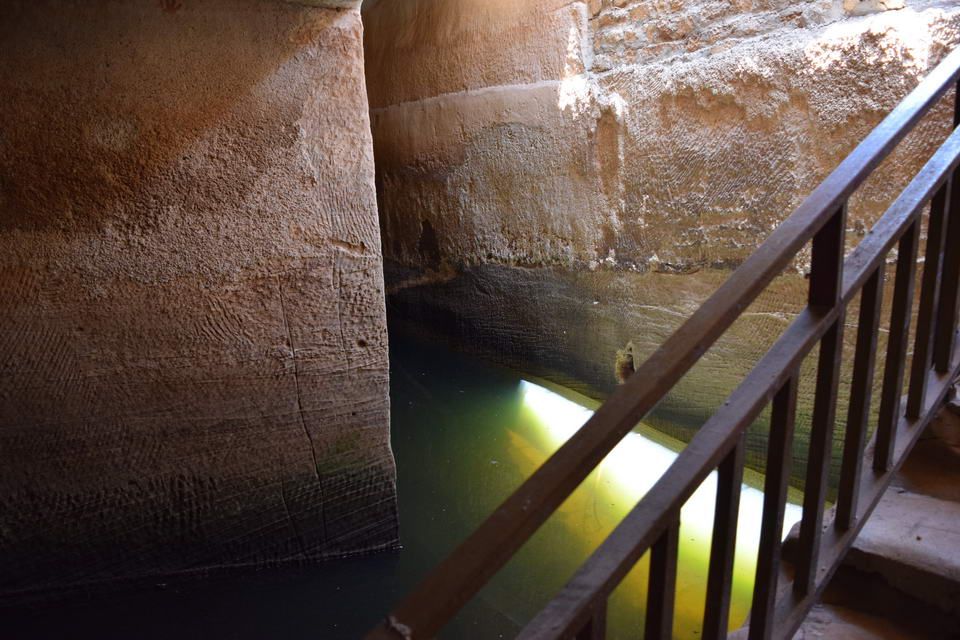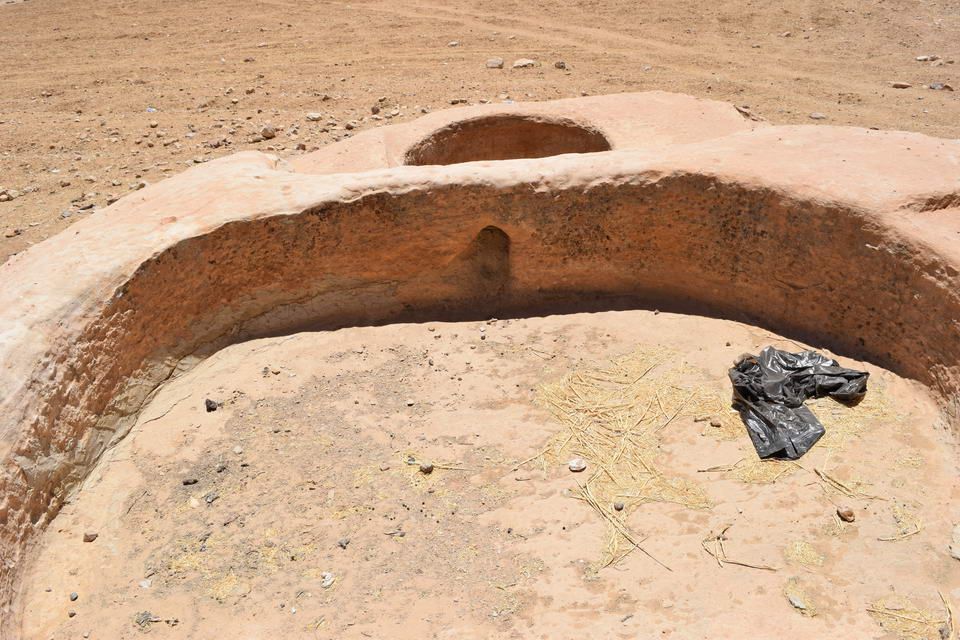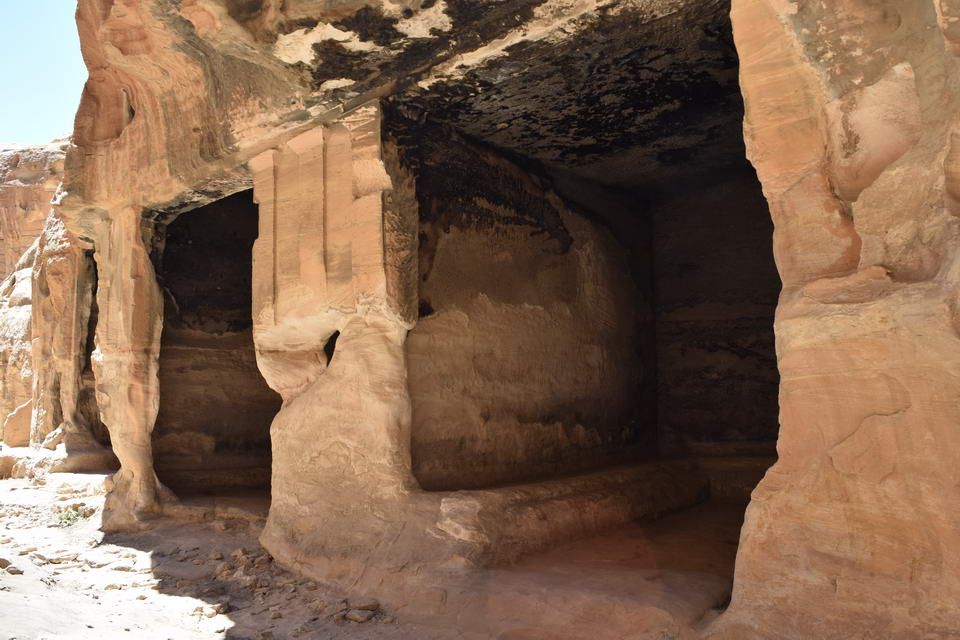Petra is a huge place, and you need definitely number of days in order to visit most important sites on Petra city, and longer time indeed to visit every place on Petra.Some places are not visited at all by the tourists mostly cause of the lake of time on their schedule even these places does worth a trip visit,
different places and spots you can see her and there , even while just passing through by the vehicle from back area to front area of Petra you will pass tens of spots and you can see some of them even from the car while passing.
One of the these hidden places in Petra what is called Little Petra , and the name came from the fact that its possible to see somehow a module of Petra and passing through this model in around an hour , while Petra itself it needs around 6 hours to pass through the main sites (From the Treasury to Ad Dair “the Monastery” ,
Worthmentioning that during my visit to the site , I did not see anyone , any tourism on the whole site and I was really supprised with that ..
Bir al-Arayis - Al-Arayis Well
First Century BC-First Century AD
This is the largest enclosed Nabataean cistern that has been found in the area, with a storage capacity of about 12 million liters of water. The Nabataeans built a dam and channel that directed rainwater from the mountain above into the cistern, enabling them to collect water from a huge catchment area. The cistern served the residential area of Bayda and also may have provided water to trade caravans, which would stop here on the way into or out of Petra. About 200 Nabataean cisterns have been found in and around Petra to date.
This cistern was restored to serve the community living in the Bayda area, and it is known as Bir al-Arayis (cistern of the brides) by the Bedouin. The name derives from a local tradition whereby brides would be taken here to bath in preparation for their wedding night and would leave their mark in the form of red henna handprint. Afterwards, it would be the bridegroom’s turn, and he would leave a black henna handprint. The cistern is no longer used for this purpose but you can still see some handprints along the upper part of the walls, though most would have been washed away.
Al-Imti Canyon (100 BC-300 AD)
Several Nabataean structure have been unearthed at Al-Imti Canyon, leading some archaeologists to believe that the area was probably a large open market for caravans on their way to and from Petra. Archaeological fieldwork conducted here between 2003-2004 uncovered major water installations, such as cistern; Nabataean rock-cut halls, some of which may have been used for ritual dining and drinking two wine presses, the ground plans of which are shown here; and traces of a huge, square-shapped open building that measured 24.5 meters on each side.
Nabataean graffiti has been scratched into the rock at several places along the eastern ridge of Al-Lmti. Also at the entrance of a triclinium found here, there is an inscription that refers to ‘Merzeha’. Merzeha was the name of a Nabataean religious group that held ritual gatherings led by a priest, and this group was widely known in ancient Palmyra. The inscription also refers to a person called Ganem (Ganamu), who was in charge of the ritual gatherings, and his son Wa’el, and indicate that ritual gatherings were held in the triclinium. According to the Greek historian/geographer Strabo (63 BC-23AD) such gathering comprised 13 people.
Siq al-Barid, Bayda (First century AD)
Located in the northern suburb of Petra, Siq al Barid was a halting station outside the main city for trade caravans coming to and from southern Arabia and Gaza. Caravans would stop here for a while, taking refuge in the cool, sheltered spaces to rest, feast and conduct business. Siq al Barid is something referred to as “Little Petra” because there is a natural cleft in the rock that is similar to the Siq, though much smaller, which forms the entrance to the area. It was gated and inside there is a complex of cistern and dams, along with dining halls and carved facades. All the needs of traders were provided for here; the cistern supplied water and Bayda was a centre of agriculture production.
Also there are several tricliniums or dining halls in Bayda , which may have been used to receive visitor and for ritual dining . The custom of organized feasting was apparently widespread and it is confirmed by a passage by the ancient writer Starbon , which said "They { the Nabataeans } organize common meals together in groups of thirteen persons , and they have two girl – singers for each banquet . The king holds many drinking – bouts in magnificent style , but no one drinks more than eleven cupfuls , each time using a different golden cup . The king is so democratic that in addition to serving himself , he sometimes even serves the rest himself in his turn” .
Excavations in Petra and at other Nabataean sites have unearthed pottery statues representing musicians with their instruments. These statues one of which is illustrated here , possibly replicate what took place at ritual dining and banquets , and they also show the type of instruments used at that time .

The Painted Biclinium (No. 849) / First Century AD
This is one of the most important monuments in Petra because inside is one of the few surviving examples of Nabataean fine painting. The biclinium so-called as it has benches carved along two of its walls, it reached by a rock-cut staircase, which is now quite deteriorated. Overlooking the threshold there is a small rectangular niche that contains a carved baetyl representing the god Dushara. Inside there is a vaulted alcove in its back wall, as illustrated in the ground plan shown here. On the ceiling of the alcove you will see what remains of a lovely intricate painting of grape vines, flower, birds and cherubic figure. The influence of Roman mythology is evident here as the room contains drawings of many Roman gods, including the famous Cupid – son of Venus, goddess of love and beauty – who was known for his arrows, which made people fall in love when pierced by them.

Bayda Church (Fourth –Sixth Century AD)
This hall, cut out of the rock, was originally Nabataean, and in the later Byzantine era it was converted into a church. This alteration include some modifications , such as carving out an apse that include a bishop’s chair in the eastern wall of the chamber. The row of small holes in the back wall could have been used to support a stucco finish for the wall and the larger niches above it may have held oil lamps for lighting. During Nabataeans times it may have been used as religious hall. This is not the only Nabataean monument that was re-used as a church by the Byzantine. Others include the Urn Tomb and the Monastery, which has crosses carved in its walls.
Umm Qussa Hall (1st century BC- 1st century AD)
This vaulted triclinium is a sacred hall that is a part of a large Nabataean complex, which is spread over an extensive area. The design of this hall is unique as it has a vaulted ceiling and does not have benches carved along its side - a feature that was typical of Nabataean sacred halls and spiritual spaces, where funeral feasts were held. In addition to this sacred hall, the complex contains a number of rock-cut installations, including quarries, several cisterns for storing water, a large pool, and numerous steps and channels cut out of the sandstone rock. Rock carvings representing animals and Nabataean graffiti have also been found within this complex. The installations were reused in the Roman and Byzantine period.
